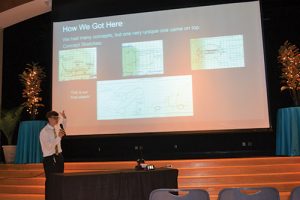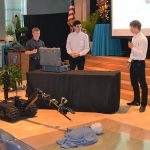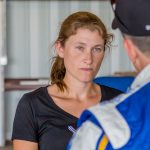
NEWARK – Worcester Technical High School engineering students showcased their efforts to solve real-world problems as they presented capstone projects this week.
Improvements to the Ocean City Bomb Squad’s robot, attachments for chainsaws and vehicle organizers were among the projects developed by seniors in Valerie Zienty’s pre-engineering class at Worcester Tech.
“Capstones teach students how long-term projects work,” Zienty said. “They pick something they’re passionate about, or something that’s a problem in the community, and then they do it themselves…they can say something I made made a difference.”
Students, who worked in teams of two or three, presented their innovations and inventions to classmates as well as a panel of judges. Judges included Delegate Wayne Hartman, Steve Habeger, a U.S. Navy engineer who has worked at Wallops Island and acted as a consultant for Northup Grumman, and Philip Cathell, a mechanical engineering manager for NASA Sounding Rocket Operations Contract.
Students told the judges how they came up with their projects and the challenges they encountered during the development process.
Three of the 11 teams that participated focused on coming up with projects that would improve the effectiveness of the robot used by the Ocean City Bomb Squad. Deputy Fire Marshal Josh Bunting learned of the pre-engineering program at Worcester Tech and approached Zienty’s class to see if they could improve the performance of the bomb squad’s robot.
“I met with the whole class the first day and basically roundtable brainstormed with some things that we would love to see that were either not available on the commercial market or were really really expensive on the commercial market,” Bunting said.
Two teams developed attachments for the robot that improved its efficiency. Another group combined a radio-controlled car and a drone camera to develop a method of mobile surveillance for Bunting’s team. Students said they were thrilled to work on such an important project.
“We came up with the thought that if we were able to solve this problem we’d potentially save hundreds of lives,” said Kyle Elliott, whose group developed an actuator, or rod, that extends a utility tool from the robot so that it can perform various tasks during an emergency situation.
Bunting said he was impressed with the solutions the groups had come up with for the robot. He pointed out that the prototypes worked and could be put into use now.
“It was a great opportunity for the bomb squad out of Ocean City to work with some young minds,” he said. “I was very impressed. They really met my expectations. There’s some really good design applications that I think we can build upon.”


